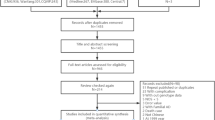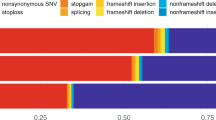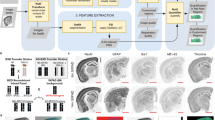Abstract
To analyze pedigrees with quantitative trait (QT) and sequence data, we developed a rare variant (RV) quantitative nonparametric linkage (QNPL) method, which evaluates sharing of minor alleles. RV-QNPL has greater power than the traditional QNPL that tests for excess sharing of minor and major alleles. RV-QNPL is robust to population substructure and admixture, locus heterogeneity, and inclusion of nonpathogenic variants and can be readily applied outside of coding regions. When QNPL was used to analyze common variants, it often led to loci mapping to large intervals, e.g., >40 Mb. In contrast, when RVs are analyzed, regions are well defined, e.g., a gene. Using simulation studies, we demonstrate that RV-QNPL is substantially more powerful than applying traditional QNPL methods to analyze RVs. RV-QNPL was also applied to analyze age-at-onset (AAO) data for 107 late-onset Alzheimer’s disease (LOAD) pedigrees of Caribbean Hispanic and European ancestry with whole-genome sequence data. When AAO of AD was analyzed regardless of APOE ε4 status, suggestive linkage (LOD = 2.4) was observed with RVs in KNDC1 and nominally significant linkage (p < 0.05) was observed with RVs in LOAD genes ABCA7 and IQCK. When AAO of AD was analyzed for APOE ε4 positive family members, nominally significant linkage was observed with RVs in APOE, while when AAO of AD was analyzed for APOE ε4 negative family members, nominal significance was observed for IQCK and ADAMTS1. RV-QNPL provides a powerful resource to analyze QTs in families to elucidate their genetic etiology.
This is a preview of subscription content, access via your institution
Access options
Subscribe to this journal
Receive 12 print issues and online access
$259.00 per year
only $21.58 per issue
Buy this article
- Purchase on SpringerLink
- Instant access to full article PDF
Prices may be subject to local taxes which are calculated during checkout


Similar content being viewed by others
References
Nicolae DL. Association tests for rare variants. Annu Rev Genomics Hum Genet. 2016;17:117–30.
He Z, Zhang D, Renton AE, Li B, Zhao L, Wang GT, et al. The rare-variant generalized disequilibrium test for association analysis of nuclear and extended pedigrees with application to Alzheimer disease WGS data. Am J Hum Genet. 2017;100:193–204.
Santorico SA, Hendricks AE. Progress in methods for rare variant association. BMC Genet. 2016;17:S6.
Chen H, Meigs JB, Dupuis J. Sequence kernel association test for quantitative traits in family samples. Genet Epidemiol. 2013;37:196–204.
MacCallum RC, Zhang S, Preacher KJ, Rucker DD. On the practice of dichotomization of quantitative variables. Psychol Methods. 2002;7:19–40.
Haseman JK, Elston RC. The investigation of linkage between a quantitative trait and a marker locus. Behav Genet. 1972;2:3–19.
Elston RC, Buxbaum S, Jacobs KB, Olson JM. Haseman and Elston revisited. Genet Epidemiol. 2000;19:1–17.
Sham PC, Purcell S. Equivalence between Haseman-Elston and variance-components linkage analyses for sib pairs. Am J Hum Genet. 2001;68:1527–32.
Sham PC, Purcell S, Cherny SS, Abecasis GR. Powerful regression-based quantitative-trait linkage analysis of general pedigrees. Am J Hum Genet. 2002;71:238–53.
Allison DB, Neale MC, Zannolli R, Schork NJ, Amos CI, Blangero J. Testing the robustness of the likelihood-ratio test in a variance-component quantitative-trait loci–mapping procedure. Am J Hum Genet. 1999;65:531–44.
Mackay TF, Stone EA, Ayroles JF. The genetics of quantitative traits: challenges and prospects. Nat Rev Genet. 2009;10:565.
Drinkwater NR, Gould MN. The long path from QTL to gene. PLoS Genet. 2012;8:e1002975.
Greenberg DA, Abreu PC. Determining trait locus position from multipoint analysis: accuracy and power of three different statistics. Genet Epidemiol. 2001;21:299–314.
Zhao L, He Z, Zhang D, Wang GT, Renton AE, Vardarajan BN, et al. A rare variant nonparametric linkage method for nuclear and extended pedigrees with application to late-onset Alzheimer disease via WGS data. Am J Hum Genet. 2019;105:822–35.
Wang GT, Zhang D, Li B, Dai H, Leal SM. Collapsed haplotype pattern method for linkage analysis of next-generation sequence data. Eur J Hum Genet EJHG. 2015;23:1739–43.
Van Cauwenberghe C, Van Broeckhoven C, Sleegers K. The genetic landscape of Alzheimer disease: clinical implications and perspectives. Genet Med. 2016;18:421.
Lee JH, Cheng R, Vardarajan B, Lantigua R. Genetic modifiers of age at onset in carriers of the G206A mutation in PSEN1 with familial Alzheimer disease among Caribbean hispanics. JAMA Neurol. 2015;72:1043–51.
Hayashi K, Furuya A, Sakamaki Y, Akagi T, Shinoda Y, Sadakata T, et al. The brain-specific RasGEF very-KIND is required for normal dendritic growth in cerebellar granule cells and proper motor coordination. PLoS ONE. 2017;12:e0173175.
Cacace R, Sleegers K, Van Broeckhoven C. Molecular genetics of early-onset Alzheimer’s disease revisited. Alzheimers Dement. 2016;12:733–48.
Aikawa T, Holm M-L, Kanekiyo T. ABCA7 and pathogenic pathways of Alzheimer’s disease. Brain Sci. 2018;8:27.
Kunkle BW, Grenier-Boley B, Sims R, Bis JC, Damotte V, Naj AC, et al. Genetic meta-analysis of diagnosed Alzheimer’s disease identifies new risk loci and implicates Aβ, tau, immunity and lipid processing. Nat Genet. 2019;51:414.
Abecasis GR, Cherny SS, Cookson WO, Cardon LR. Merlin–rapid analysis of dense genetic maps using sparse gene flow trees. Nat Genet. 2002;30:97–101.
Karczewski KJ, Francioli LC, Tiao G, Cummings BB, Alföldi J, Wang Q, et al. Variation across 141,456 human exomes and genomes reveals the spectrum of loss-of-function intolerance across human protein-coding genes. bioRxiv. 2019;30:531210.
Lek M, Karczewski KJ, Minikel EV, Samocha KE, Banks E, Fennell T, et al. Analysis of protein-coding genetic variation in 60,706 humans. Nature. 2016;536:285–91.
Matise TC, Chen F, Chen W, Francisco M, Hansen M, He C, et al. A second-generation combined linkage–physical map of the human genome. Genome Res. 2007;17:1783–6.
Li B, Wang GT, Leal SM. Generation of sequence-based data for pedigree-segregating Mendelian or Complex traits. Bioinformatics. 2015;14:btv412.
Lander E, Kruglyak L. Genetic dissection of complex traits: guidelines for interpreting and reporting linkage results. Nat Genet. 1995;11:241–7.
Mandal DM, Wilson AF, Elston RC, Weissbecker K, Keats BJ, Bailey-Wilson JE. Effects of misspecification of allele frequencies on the Type I error rate of model-free linkage analysis. Hum Hered. 2000;50:126–32.
Risch NJ, Zhang H. Mapping quantitative trait loci with extreme discordant sib pairs: sampling considerations. Am J Hum Genet. 1996;58:836–43.
Allison DB. The use of discordant sibling pairs for finding genetic loci linked to obesity: practical considerations. Int J Obes Relat Metab Disord J Int Assoc Study Obes. 1996;20:553–60.
Allison DB, Heo M, Schork NJ, Wong S-L, Elston RC. Extreme selection strategies in gene mapping studies of oligogenic quantitative traits do not always increase power. Hum Hered. 1998;48:97–107.
Mandal DM, Sorant AJ, Atwood LD, Wilson AF, Bailey-Wilson JE. Allele frequency misspecification: effect on power and Type I error of model-dependent linkage analysis of quantitative traits under random ascertainment. BMC Genet. 2006;7:21.
He Z, O’Roak BJ, Smith JD, Wang G, Hooker S, Santos-Cortez RLP, et al. Rare-variant extensions of the transmission disequilibrium test: application to autism exome sequence data. Am J Hum Genet. 2014;94:33–46.
Vardarajan BN, Ghani M, Kahn A, Sheikh S, Sato C, Barral S, et al. Rare coding mutations identified by sequencing of Alzheimer disease genome-wide association studies loci. Ann Neurol. 2015;78:487–98.
Acknowledgements
We wish to thank the family members who participated in the Alzheimer Disease Sequencing Project and made this research possible. We also thank Katherine Montague for proof-reading this manuscript. The datasets used for the analyses in this manuscript were obtained from the database of Genotypes and Phenotypes (dbGaP) through dbGaP accession study number phs000572.v7.p4. We would like to thank dbGaP for distributing the data used in this study. We thank contributors, including the Alzheimer’s disease Centers who collected samples used in the NIA-LOAD study, as well as patients and their families, whose help and participation made this work possible. We also acknowledge the Genetic Studies of Alzheimer’s disease in Caribbean Hispanics (EFIGA) study participants and the EFIGA research and support staff for their contributions to this study. Complete acknowledgments can be found in the Supplemental Acknowledgments.
Funding
The National Institute on Aging (NIA)-LOAD supported the collection of samples used in this study through NIA grants U24AG026395, R01AG041797, 5R37AG015473, RF1AG015473, and R56AG051876. This work was also supported by grants from the National Human Genome Research Institute R01 HG008972 and NIA RF1 AG058131.
Author information
Authors and Affiliations
Corresponding author
Ethics declarations
Conflict of interest
The authors declare that they have no conflict of interest.
Additional information
Publisher’s note Springer Nature remains neutral with regard to jurisdictional claims in published maps and institutional affiliations.
Supplementary information
Rights and permissions
About this article
Cite this article
Zhao, L., Zhang, Z., Rodriguez, S.M.B. et al. A quantitative trait rare variant nonparametric linkage method with application to age-at-onset of Alzheimer’s disease. Eur J Hum Genet 28, 1734–1742 (2020). https://doi.org/10.1038/s41431-020-0703-z
Received:
Revised:
Accepted:
Published:
Issue date:
DOI: https://doi.org/10.1038/s41431-020-0703-z



